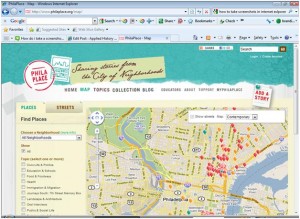For this project I became interested in learning more about what historical consultants do and how an independent consultant can operate their own business. After some online research, I decided to interview the owners of TAG Historical Research and Consulting, one of the leading historical consulting firms in Boise. I went over to their downtown office one afternoon, and interviewed Barbara Perry Bauer and her sister, Elizabeth Jacox about their experiences running their own firm and how they got there.
Barbara went to school for a degree in history, and worked in a museum, which was work she really enjoyed. As we talked about the path Barbara took to get where she is today, she said that “it was a circuitous path.” She ended up going to Wyoming and working in another museum, then her husband was offered a job in Boise, so they picked up and came here. Barbara worked as the Director of the Basque Museum for two years, and after that she kept her foot in the door by volunteering at the history institutions around town. In 1993, Barbara and a group of other historians came together and formed a historical consulting firm. Through time the others fell away, and Barbara’s sister Elizabeth joined. Barbara mentioned that it was a lot of building up her resume and networking, and she has always felt lucky, being in the right place at the right time.
Part of their success can be attributed to their diversification in projects. Elizabeth mentioned that it is the only way to exist in this business. TAG does lots of Section 106 compliance work, site surveys, house histories, and exhibits. One amazing fact I learned was that almost all of the site surveys since 1989 in Boise have been completed by TAG. Barbara and Elizabeth also work with engineers, developers, attorneys, city and county agencies, and non-profits. They market their business in a variety of ways to their different clients, and they have repeat clientele, as well as a great reputation. They are also members of the American Cultural Resource Organization.
They encourage anyone who wants to become a historical consultant at an entry-level position to have good research experience, as well as writing skills, including technical writing as you end up writing a lot of reports. In addition to this, some basic organizational skills are a must, and some GIS experience can be helpful. The official salary for entry level is $12-15/hr, and with a Master’s, working on your own $14-15/hr is a dream figure. Barbara and Elizabeth added that the hourly rate you charge is no where the rate you end up paying yourself. As Elizabeth said though, the reason you do this is not always practical.
This leads into the current issues facing the historical research business. TAG has felt the decline in the economy much like other small businesses. For history consulting work, it has been a trickle-down effect: less work for transportation departments, developers, etc., means less work for history consultants. It was particularly bad in 2010 with the stimulus bill because the Feds loosened up regulations to get people to work, bypassing section 106 rules to a degree to get it accomplished, which funny enough, put other people out of work.
To end on a positive note, Barbara and Elizabeth hope to grow their business large enough to hire recent history graduates of BSU. They also encourage anyone interested in becoming a history consultant to try and hook up with a federal or local government agency because that is where they think the most growth will occur for recent history graduates. Barbara and Elizabeth ended the interview by saying that they love what they do, and would not want to be doing anything else.
I appreciated my time with them, and I am glad that Boise has such an outstanding firm that does such great work with our history.
